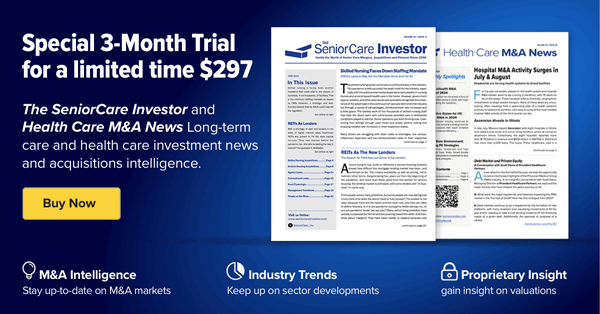Believe it or not, 2020 is over in just a few short weeks. Although most of our attention has been absorbed by the pandemic, the presidential election and an endless amount of Zoom calls at work, the healthcare M&A market managed to pull off some eye-catching surprises. The raw numbers and data might pale in comparison to that of 2019, but the activity is worth digging through.
Early in December, there have been 1,374 deals announced, according to search results in our Healthcare Deal Database, a roughly 25% drop compared with the 1,841 deals on the books in 2019. Based on our monthly averages for the year, we might see somewhere between 100 and 120 more deals added by the end of December (following more revealed
in quarterly and annual earnings reports), but with rising Covid-19 cases taking significant tolls on public health and the economy, investors might hit pause for the holidays.
Disclosed prices have reached a modest $204.1 billion so far, more than we would have expected at the beginning of March when the World Health Organization declared the Covid-19 outbreak a pandemic. Comparing spending in 2020 and 2019 doesn’t seem fair since last year there was AbbVie’s (NYSE: ABBV) $87 billion takeover of Allergan plc and Bristol-Myers Squibb‘s (NYSE: BMY) acquisition of Celgene Corporation valued at $75 billion. In 2019, more than $407 billion in total spending was announced.
The Biotechnology sector scored six of this year’s top-10 deals, with eHealth (2), Medical Devices and Other Services taking up the rest. The largest deal of the year was the acquisition of oncology-research firm Immunomedics (NASDAQ: IMMU) by Gilead Sciences, Inc. (NASDAQ: GILD) for $21 billion. Gilead also purchased Forty Seven, Inc. (also an oncology-research firm) in early March for $4.9 billion, another deal in the top 10.
Gilead’s ambitions in the oncology market aren’t an outlier. Companies such as Merck & Co., Inc. (NYSE:
MRK), Illumina (NASDAQ: ILMN) and AstraZeneca plc (NYSE: AZN) all announced acquisitions or licensing deals
focused on cancer therapeutics. We have no doubts the focus on the oncology market will only intensify in 2021.
We can’t discuss trends in 2020 without mentioning eHealth, or more specifically, telehealth. The demand for virtual care services exploded in response to the Covid-19 pandemic, and no deal highlights that more than Teladoc Health, Inc.‘s (NYSE: TDOC) purchase of Livongo Health, Inc. in the year’s second-largest transaction, valued at $18.5 billion. The combination creates a global leader in consumer-centered virtual care, and the company is expected to have an estimated 2020 pro forma revenue of approximately $1.3 billion, representing year-over-year pro forma growth of 85%.
Further, the Centers for Medicare and Medicaid Services recently released a rule that adds more than 60 services
to the Medicare telehealth list that will continue to be covered beyond the Covid-19 crisis, an indication that telehealth will be here to stay in 2021 and beyond.
The only services deal to break into the top 10 was MultiPlan, Inc.‘s reverse merger with Churchill Capital Corp III, a special purpose acquisition company (SPAC), valued at $11 billion. MultiPlan is a provider of end-to-end healthcare cost management solutions, and trusted partner to over 700 healthcare payers in the commercial health, dental, government and property, and casualty markets, and saves these companies approximately $19 billion annually. Revenues and EBITDA in 2021 were estimated to be $1.085 billion and $845 million, respectively. The deal has actually closed, and the company is now called MultiPlan Corporation (NYSE: MPLN). In November, Multiplan purchased HST, a healthcare payment management company, for $140 million. It looks like Multiplan is hitting the ground running.
SPACs saw something of a resurgence in 2020. Usually just seen as a vehicle for a private company to skip the IPO process and go to market quicker, these companies were “buyers” in 11 deals throughout the year, across multiple sectors. Three were announced in November alone: Cano Health, LLC went public in a $4.4 billion deal, Butterfly Network, Inc. followed suit in a reverse merger valued at $1.5 billion and UpHealth Holdings, Inc. and Cloudbreak Health, LLC merged through a SPAC in a $1.35 billion transaction. The rising popularity of SPACs isn’t isolated to the healthcare M&A market as well, so we expect to see much more of them in 2021.
Hospice providers were also hot targets this year, underscored by H.I.G. Capital’s $580 million purchase of St. Croix Hospice from The Vistria Group and the acquisition of AseraCare Hospice for $203 million by Amedisys, Inc. (NASDAQ: AMED). Stable reimbursement and payment rates in hospice care attracted investors in 2020, and there doesn’t seem to be any changes on the horizon to soften interest.
And much like in 2019 and 2018, private equity remained active buyers. PE firms, whether as a direct add-on or through a sponsored company, accounted for 21% of all transactions and 11% of all announced spending. As physician groups and other healthcare service providers dealt with the economic pressures of the pandemic, PE buyers turned toward eHealth, Medical Devices and Pharmaceuticals. In the largest purchase by a PE firm in 2020, Veritas Capital Management LLC acquired the U.S. State and Local Health and Human Services business of DXC Technology (NYSE: DXC) for $5 billion.
There’s the obvious chance another large deal could come along before New Year’s Eve, but we expect that most investors (and the entire world, frankly) will be waiting for Covid-19 vaccines to get approved and distributed. That will take some time, but hopefully, by this time next year, we’ll be in the clear.


